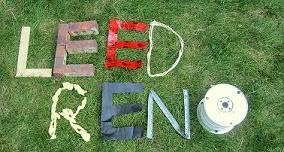The idea behind this category is to encourage people to build at locations that minimize environmental impact and encourage a healthy lifestyle. If you choose to build your home in a swift fox breeding ground and need to helicopter in your groceries: you won't get any points. Incidentally you can still qualify for LEED; this is the only category with no prerequisites. I am guessing so that mountain top lodges in National Parks can still qualify.
We cleaned up in this category for two reasons:
#1 We're Renovating
- Our land was already developed so we are not consuming environmentally sensitive land: 2 points (LL2.1 - this is the category code for those of you following along at home with your own handy rating guide)
- We aren't causing any Urban Sprawl. We get 2 points for being bordered by existing developments on at least 75% of the property (LL3.2) and 1 point for being a previously developed lot ourselves (LL3.3)
- Infrastructure already exists so they don't need to run more sewers or power lines - 1 point (LL4.1)
#2 Where we bought
We had the luxury of when we were buying the house, we were buying it with the intention of trying to complete a LEED reno. So we were looking for the right kind of location. LEED encourages houses to be placed in locations where you have access to green space and don't need a car for your daily life. Unless you are buying a new place, not much you can control here as part of a reno project.
To see what points you would get just pull up Google Earth and draw a circle that is 800m away from your house. That's essentially the cutoff for what is considered a reasonable walk.

If a park 3/4 of an acre or bigger (think the size of a kid's baeeball diamond) is in your circle that's 1 point (LL6.1)
Now count how many services are in that range. The key here is you can't count more than two of the same type. So if you are by a strip mall consisting of 25 restaurants it only counts for two services. If you have 7 to 10 services that's one point, 11 to 13 is two points and 14 or more is three points (LL5.3)
Our count is:
• 1 movie theatre
• >2 Banks
• 2 Community or civic centres
• 2 Convenience stores
• 2 Daycare centres
• 0 Fire stations
• 0 Fitness centres or gyms
• 1 Laundry or dry cleaner
• 0 Libraries
• 2 Medical or dental offices
• 1 Pharmacy
• 0 Police stations
• 1 Post office
• 2 Places of worship
• >>>2 Restaurants (we are near that strip mall with 25 restaurants)
• 1 School
• 2 Supermarkets
• 2 other neighbourhood-serving retail
• 2 other office buildings or major employment centres
So we finish the count with 25! Comfortably putting us into the 3 point group.
If you have no services in your 800m circle it may not mean the end. You can count the number of times public transit stops within the circle instead. If there are 30, 60 or 125 buses per day than you can get the one, two or three points as well. You count the number of buses at each stop, so one bus stopping at 5 stops in your circle counts as 5 buses.
So just like that we have 10 points. 22% of the way to certification and we haven't even done anything yet!


